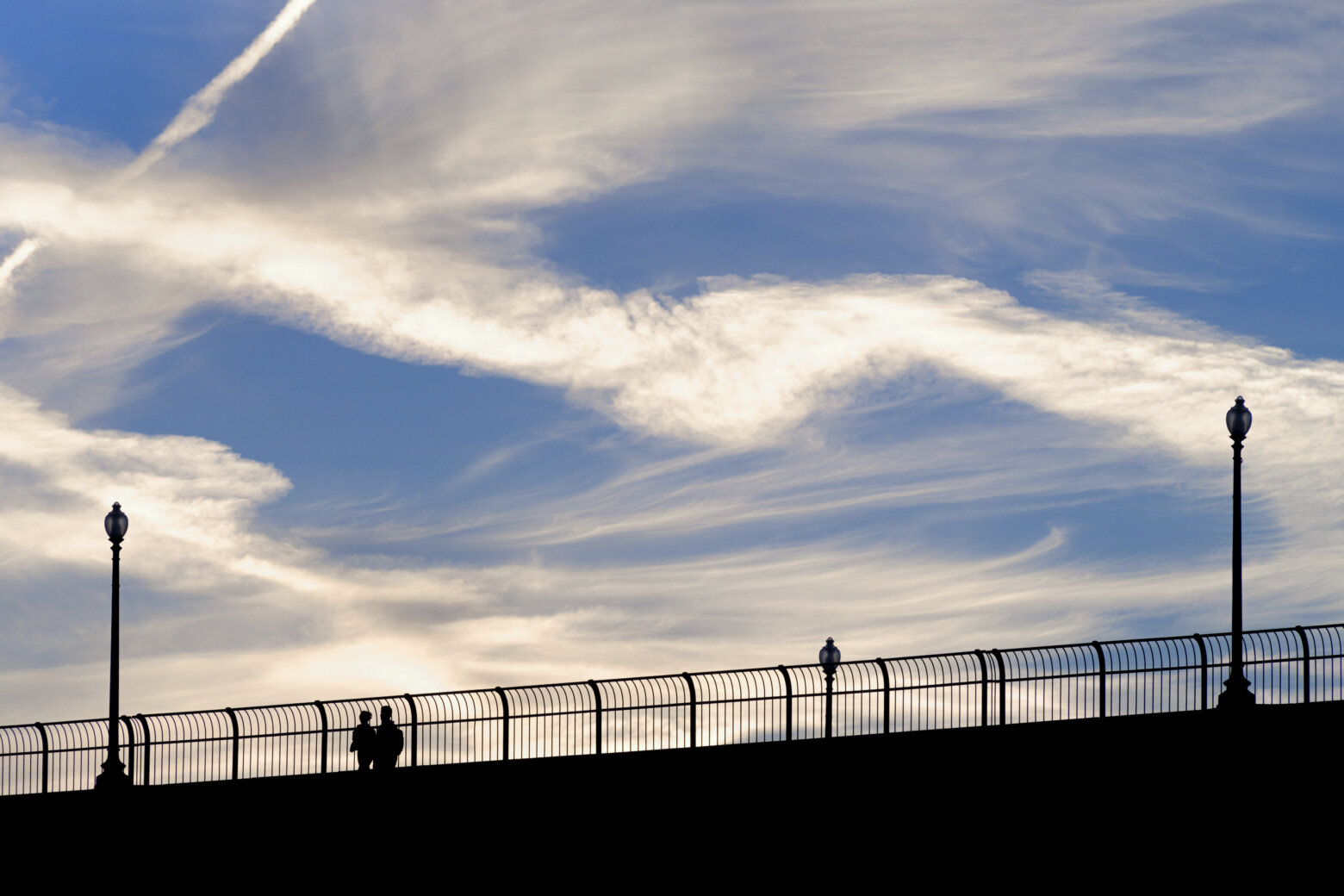In explaining how the sustained drought in California and other parts of the West might be affecting people living through it, experts point not only to parched ground but to the hazy skies.
Specifically, the spikes in so-called particulate matter, or particle pollution, that obscures views, resulting from blazes sparked in the prolonged dry heat. “I think the clearest link between drought conditions and respiratory health is mediated by increased frequency and severity of wildland fires,” says Dr. Paul Blanc, a professor of medicine and endowed chair in occupational and environmental medicine at the University of California–San Francisco.
The combustion byproducts in smoke can drift for miles, even hundreds of miles, across city, state and sometimes international boundaries, as in the case of a rash of fires in the Southwest, West, Canada and Alaska during a roughly half-decade long period of drought. “In drying out the earth, the drought is just really adding to so much of the extraordinary number of wildfires we’re seeing right now,” says Janice Nolen, assistant vice president for national policy for the American Lung Association.
The offending particles spewed into the air by these fires — and sometimes dust kicked up by the thirsty earth — are exceedingly minuscule, roughly 1/30th the diameter of a human hair, Nolen says. But they can wreak havoc on a person’s health on a grand scale.
“They are so tiny that they bypass the body’s natural defense systems and lodge deep in the lungs, and some of them are so tiny they can actually pass through into the blood system. Because of their size, and because of the way they affect the body, they can have profound health implications,” she says. “They can kill people. They can shorten lives by months to years. They can cause asthma attacks, heart attack [and] stroke.”
Researchers are now looking into the possibility that particle pollution may also cause low birth weight in infants and affect the body’s central nervous system and reproductive system. “In 2013, the World Health Organization said particle pollution could actually cause lung cancer,” Nolen says.
The ALA’s most recent State of the Air 2015 report, which looked at particle pollution and ozone pollution, or smog, from 2011 to 2013, found that the effects of continued drought — particularly the spate of wildfires — fueled dangerous spikes in levels of particle pollution in affected regions. That goes against a decade-long trend of decreasing particle pollution, based on concerted efforts to reduce pollution from sources such as automobiles and industry.
Nationally, the report, released in April, found that nearly 24 million people live in counties that have “unhealthful year-round levels of particle pollution.” While it noted annual improvements in areas across the U.S., from the East and South to Los Angeles, Nolen pointed to a half dozen cities that saw record high short-term particle pollution levels during the study period, from Phoenix, Reno, Nevada, Visalia, California, and the greater San Francisco-Oakland area, primarily San Joaquin County; to Yakima, Washington, and Fairbanks, Alaska. “Those areas that have been part of that massive western half of the U.S. drought that we’ve seen — and Alaska,” she says, noting an extraordinary number of fires in that state. She adds that drought and wildfires add to the daily levels of particle pollution and can worsen the year-round averages.
The ALA study covered three years in the midst of the drought that continues today. Next year’s study will look at 2014 particle pollution levels, and this year’s air pollution levels will be reported by the ALA in 2017. “We’ll see what we see with the 2014 data and the 2015 data, but it looks like we’re still going to be recognizing that these wildfires are adding significantly to the [air pollution] burden of very large cities,” she says.
Blanc — whose research and clinical focus are primarily lung disease and its relationship to work and the environment — says data suggest that those most at risk for respiratory issues related to high particle pollution levels are people with underlying lung disease. That includes individuals with asthma and COPD for whom, he says, particle pollution can exacerbate symptoms ranging from cough to bronchospasm, or constriction of muscles that can cause mild to severe difficulty in breathing.
Blanc says he’s relatively distant from current blazes and, as a result, hasn’t treated any patients recently for fire-related health complaints. Not far away, Dr. James Brown, a pulmonary physician who runs a clinic for patients with lung diseases at the San Francisco VA Medical Center, has seen an uptick in patients’ respiratory health complaints related to the drought.
“Our VA serves a large part of Northern California up to the Oregon border. The most prominent effect of the drought on respiratory health right now relates to the wildfires — especially in the Lake County area,” he says. “Many of our patients with COPD or asthma are noting more cough, more need to use their inhalers and occasionally, the need to just stay inside. Some are leaving their homes to stay with friends or relatives in other parts of the state.”
Nolen says the risks from higher particle pollution levels include not only people with respiratory conditions but the general populace, as well as children and younger people, given that their lungs are still developing. According to the ALA, girls’ lungs don’t reach their full size until they’re in their late teens, and boys’ lungs continue growing past age 20. In addition, she says, at-risk groups cover older adults, individuals with cardiovascular disease and people with diabetes. “Often they are at risk, especially from particle pollution, not only because they have a higher risk of cardiovascular disease but because at least there’s some evidence that being diabetic makes a difference,” she says. Those with diabetes face a higher risk of suffering from cardiovascular harm as a result of exposure to particulate matter. In addition, growing research finds long-term exposure to air pollution, including particulate matter, may increase one’s risk for developing diabetes. Another group at risk: low-income individuals, who already have factors working against their health, from high stress to living near industrial sources of pollution, Nolen says.
Experts say protecting lung health starts with reducing exposure to high levels of air pollution, like staying inside on days when spikes in particle pollution occur. Pay attention to local air quality indexes, Nolen says, and be proactive about evacuating an area touched by wildfire if ordered to do so. Take precautions, too, if smoke is blowing through — even if not ordered to evacuate — including rolling up car windows if you must drive and not recirculating air conditioning.
“Don’t count on a dust mask offering protection,” Nolen says. “Especially if you’ve got a lung disease, talk to your doctor.” She adds that masks don’t cover everything, just some particles.
For those with a chronic lung disease like asthma, make sure to talk to a doctor so you have all needed medications, both for management and to counteract an asthma attack. In addition, work to locate care outside your area — keeping your physician’s contact information handy — should you need to evacuate.
Blanc emphasizes that more research is needed to fully understand all the health effects of fire smoke on those in areas affected by blazes. “Unfortunately, we may be in a better position to study it as we have more and more people exposed to it in the general population level,” he says, with a continuing drought and as residential populations grow in and around wooded areas.
Thus far in parched areas, dust hasn’t played the prominent role in potentially threatening respiratory health that fire has, but Blanc speculates it could become a factor if the long drought continues.
“Though it’s not well studied, there have been some reports that show hospital admissions for respiratory conditions will increase related, in time, to dust storms, when it’s been looked at carefully,” Blanc says. “So we’re not in a situation yet where dust storms are a major side effect of our drought, but certainly worsening drought can be associated with that, and we have the historical experience of the great Dust Bowl.”
Amid the drought, he notes that the Centers for Disease Control and Prevention have found increased incidence of coccidioidomycosis, also known as valley fever, a soil-dwelling fungal disease found in parts of the Southwest and West, including California, as well as Mexico, Central and South America. “We know that dust from the ground, in periods of drought, especially drought that alternates with rain … appears to be a risk factor for the increase in lung infection with coccidioidomycosis,” Blanc says.
The CDC — which describes the overall health effects of drought as far reaching, from affecting water quality and sanitation to respiratory issues — says most people who get sick with coccidioidomycosis get better on their own within weeks to months. But some require medication, and certain groups, like those with compromised immune systems, are at risk for getting seriously ill, according to the agency.
“People who live in geographic areas with high concentrations of coccidioidomycosis in the soil [are advised] to not unnecessarily disturb soil in such areas, and again seek medical care early with unusual symptoms that could represent such problem,” Blanc says. “Luckily, the physicians who live in those areas are quite familiar with the fever and respiratory complaints that are consistent with that type of disease.”
He adds that the infection has been a big occupational problem in California, and some construction crews, for example, have been exposed to it.
Looking ahead, Blanc expects drought-related issues will continue to be a potential health threat for those living through it, as a result of larger environmental changes.
“I think inherent in all this is global climate change. We’re not simply talking about a coincidental drought, an act of God,” Blanc says. Amid fiery debate over global warming and its effects, including in California, he sees the consequences of the long dry spell as more writing on the wall. Along with physical concerns, like respiratory issues, he says it could even have psychological effects, making one a refugee in their own country if they must evacuate their home, as in the case of fire. “I think we can presume that these will be recurring problems,” Blanc says.
More from U.S. News
The Most Common Patient Complaints
How to Survive Ragweed Allergy Season
How to Avoid Summer Pest Risks — From West Nile to Chikungunya Virus
How the West’s Drought Is Affecting Lung Health originally appeared on usnews.com







